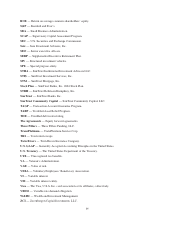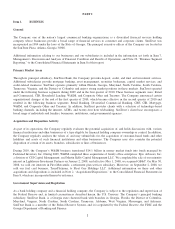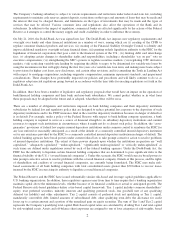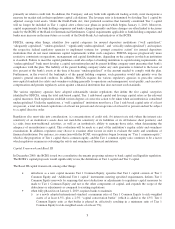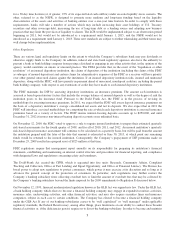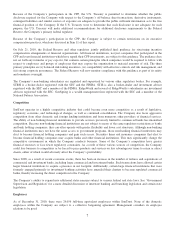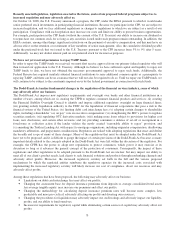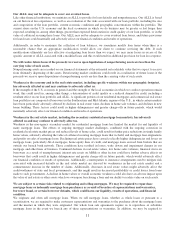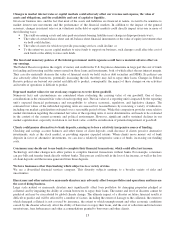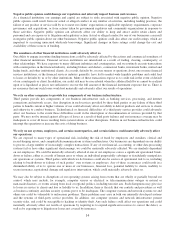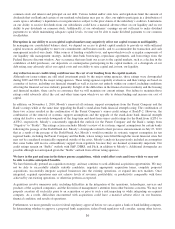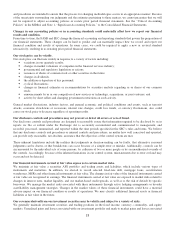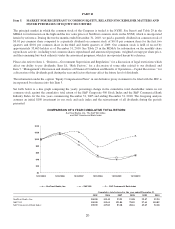SunTrust 2010 Annual Report Download - page 26
Download and view the complete annual report
Please find page 26 of the 2010 SunTrust annual report below. You can navigate through the pages in the report by either clicking on the pages listed below, or by using the keyword search tool below to find specific information within the annual report.•The ability to pay interest on commercial demand deposit accounts may increase our interest expenses; and
•The increased regulation of derivatives and proprietary trading activities may adversely affect profits.
These provisions may limit the types of products we offer, the methods of offering them, and prices at which they are
offered. They may also increase the cost of offering these products. These provisions likely will affect different financial
institutions in different ways, and therefore, may also affect the competitive landscape.
SunTrust Bank may be subject to higher deposit insurance assessments.
Pursuant to the Dodd-Frank Act, the FDIC amended its regulations regarding the assessment for federal deposit insurance to
base such assessments on the average total consolidated assets of insured depository institutions during the assessment
period, less the average tangible equity of the institution during the assessment period. Presently, we are assessed only on our
domestic deposits, and this change may result in a substantial increase in the base to which the insurance rate is applied. The
Dodd-Frank Act also eliminates Section 7(b)(2)(D) of the FDIA, which provided that no insured depository institution may
be barred from the lowest-risk category in the FDIC’s deposit insurance assessment system solely because of size. The FDIC
has also proposed regulations that would change the way the deposit insurance assessment rate is applied to banks to a
system that is risk-based. This makes a higher rate assessment possible. The cumulative effect of these provisions may be a
significant increase in the deposit insurance assessment which may adversely affect our results.
We are subject to capital adequacy and liquidity guidelines and, if we fail to meet these guidelines, our financial
condition would be adversely affected.
Under regulatory capital adequacy guidelines and other regulatory requirements, our Company and our subsidiary bank and
broker-dealers must meet guidelines subject to qualitative judgments by regulators about components, risk weightings and
other factors. From time to time, the regulators implement changes to these regulatory capital adequacy guidelines. The
Capital Framework and Basel III described in Item 1 under “Government Supervision and Regulation,” when implemented
by the U.S. banking agencies and fully phased-in, will result in higher and more stringent capital requirements for our
Company and our banking subsidiaries. Under the Dodd-Frank Act, the Federal Reserve, using a phased-in approach
between 2013 and 2016, will no longer include trust preferred and certain other hybrid debt securities in Tier 1 Capital. At
such future time, SunTrust will have approximately $2.3 billion principal amount of such securities that are currently
outstanding which we expect will be affected. Such eventual loss of Tier 1 Capital, and actions to replace such capital, may
adversely affect us. Additionally, the Basel III framework requires banks and bank holding companies to measure their
liquidity against specific liquidity tests, including a LCR, which is designed to ensure that the banking entity maintains a
level of unencumbered high-quality liquid assets greater than or equal to the entity’s expected net cash outflow for a 30-day
time horizon under an acute liquidity stress scenario, and a NSFR, designed to promote more medium and long-term funding
based on the liquidity characteristics of the assets and activities of banking entities over a one-year time horizon. If we fail to
meet these minimum liquidity capital guidelines and other regulatory requirements, our financial condition would be
materially and adversely affected. The LCR and NSFR have proposed adoption dates beginning in 2015 and 2018,
respectively.
Emergency measures designed to stabilize the U.S. banking system are beginning to wind down.
Since the middle of 2008, a number of legislative and regulatory actions have been implemented in response to the recent
financial crisis. Some of these programs have begun to expire and the impact of the wind down of these programs on the
financial sector and on the economic recovery is unknown. A stall in the economic recovery or a continuation or worsening
of current financial market conditions could materially and adversely affect our business and results of operations.
Business Risks
We are subject to credit risk.
When we loan money, commit to loan money or enter into a letter of credit or other contract with a counterparty, we incur
credit risk, which is the risk of losses if our borrowers do not repay their loans or our counterparties fail to perform according
to the terms of their contracts. A number of our products expose us to credit risk, including loans, leases and lending
commitments, derivatives, trading account assets, insurance arrangements with respect to such products, and assets held for
sale. As one of the nation’s largest lenders, the credit quality of our portfolio can have a significant impact on our earnings.
We estimate and establish reserves for credit risks and credit losses inherent in our credit exposure (including unfunded
credit commitments). This process, which is critical to our financial results and condition, requires difficult, subjective and
complex judgments, including forecasts of economic conditions and how these economic predictions might impair the ability
of our borrowers to repay their loans. As is the case with any such assessments, there is always the chance that we will fail to
identify the proper factors or that we will fail to accurately estimate the impacts of factors that we do identify.
10


